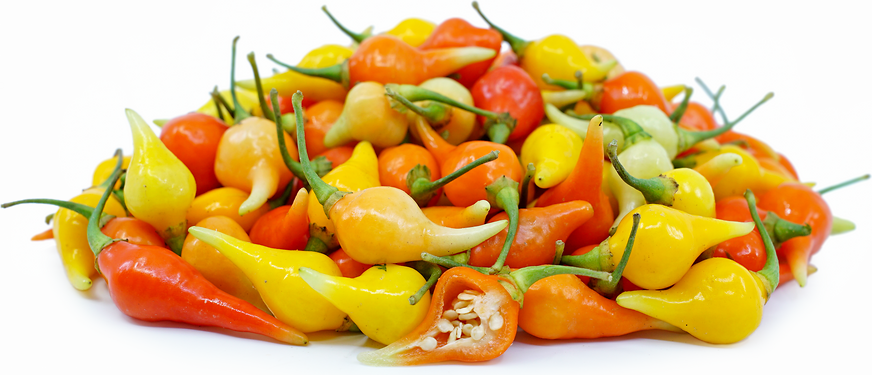


Biquinho Peppers
Estimated Inventory, lb : 0
This item was last sold on : 10/11/24
Description/Taste
Biquinho chile peppers are very small, tear-drop shaped pods, averaging three centimeters in length, and have a straight to slightly curved center with an elongated, pointed tip. The taut skin ripens from pale green when young, to orange, to bright yellow or red with maturity and is glossy, smooth, and firm, connected to a slender, green stem. Underneath the surface, the semi-thick flesh is yellow to red, depending on the variety, with a crisp and aqueous consistency. Biquinho chile peppers also encase a tiny cavity filled with tightly packed, round, cream-colored seeds. When fresh, Biquinho chile peppers have an initially tangy, citrus taste followed by a sweet, fruity, and slightly smoky flavor. The peppers also contain mild heat that fluctuates in intensity depending on the climate, soil, and environment the pod is grown in.
Seasons/Availability
Biquinho chile peppers are available in the late summer through early fall.
Current Facts
Biquinho chile peppers, botanically classified as Capsicum chinense, are small, brightly colored pods that belong to the Solanaceae or nightshade family. The peppers were first discovered growing wild in South America, and the name Biquinho translates to mean “little beak,” which is derived from the pepper’s similarity in appearance to a pointed bird’s beak. Biquinho chile peppers have a mild heat, ranging 500-1,000 SHU on the Scoville scale, and are known for bearing fruity flavors reminiscent of a habanero pepper without the intense heat. There are two primary varieties of Biquinho chile peppers, red and yellow, and both types are interchangeable, sharing a similar flavor and spice profile. In addition to the name Biquinho, the peppers are also known as Chupetinha, Chupetinho, and Pimenta de Bico in South America. Biquinho chile peppers are not commercially grown on a global scale, but the small peppers are increasing in popularity among home gardeners and specialty growers.
Nutritional Value
Biquinho chile peppers are an excellent source of vitamins A and C and also contain potassium, magnesium, iron, phosphorus, and dietary fiber. In addition to vitamins and minerals, the minimal amount of capsaicin found in the small peppers provides some anti-inflammatory properties.
Applications
Biquinho chile peppers are best suited for both raw and cooked applications such as stir-frying, sautéing, and baking. The small peppers can be chopped fresh into salsas, blended into hot sauces and marinades, or sliced and tossed into salads, soups, and stews. They can also be sliced and served as a topping over pizza, mixed into pasta, used as a garnish, or blended into pesto. In addition to fresh preparations, Biquinho chile peppers can be lightly stir-fried with other vegetables, sliced and baked into scones or bread, sautéed into rice-based dishes, or cooked into jellies or jams for a sweet, smoky flavor. Biquinho chile peppers pair well with herbs such as cilantro, basil, and parsley, meats such as barbeque beef, pork, or poultry, cabbage, legumes, dark leafy greens, and tomatoes. The peppers will keep up to one week when loosely stored whole and unwashed in a plastic or paper bag in the refrigerator.
Ethnic/Cultural Info
Biquinho chile peppers are most popularly served as a pickled condiment, utilized as a snack, flavoring, and edible garnish. In Brazil, the peppers are pickled in a solution of vinegar, garlic, herbs, and a Brazilian liquor known as cachaça. This unique liquor is made from fermented sugarcane juice and adds sweetness to the sour, vinegary brine. Once pickled, Biquinho chile peppers are typically served as an appetizer or snack at local bars, and the pickled pepper’s flavor compliments the taste of craft cocktails, balancing sweet and sour flavors. Biquinho peppers are also pickled outside of South America for use as a condiment. In the United States, pickled Biquinho chile peppers are sometimes sold under the name “Sweety Drops.”
Geography/History
Biquinho chile peppers are native to South America, initially documented in Brazil, and were believed to have first been cultivated in the Brazilian state of Minas Gerais. Today Biquinho chile peppers can be found as a popular ornamental plant in home gardens and are grown on a small scale through local farms in Brazil, Peru, and the United States. The Biquinho peppers featured in the photograph above were grown at Weiser Family Farms located in Southern California.
Recipe Ideas
Recipes that include Biquinho Peppers. One
| Soup Addict |
|
Pickled Sweety Drop (Biquinho) Peppers |
| Meatless Makeovers |
|
Biquinho Pepper Pesto |
| The Food Dictator |
|
Hirshon Brazilian Pickled Biquinho Peppers |




